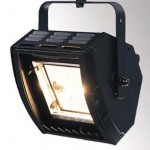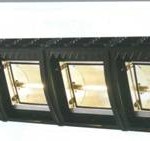Flood’s and Work Lights
Flood’s
An uncontrolled light which produces a very large area of illumination. It has no lens and relies on a large reflector to direct the light out, resulting in a cheap and efficient light which produces enormous amounts of spill. An asymmetric floodlight directs more light upwards and is used to light flat walls (or cycs). This means the part of the surface furthest away gets more light and so the wall is evenly lit. Floodlights are generally used to produce large colour washes.
Floods for lighting cycs can come in single-cell, 3-cell and 4-cell units, these make it simpler for lighting cycs with multiple colours from very similar locations. 4-cell floods are the most used for lighting cycs as they allow for 4 separate colours to be place very close to each other, this allows a designer to evenly wash the cyc.
Work Lights
Working lights are not a lantern that is used very often during a show or event. You will only normally come across when your rigging or de-rigging an event. Most venues and theatres will have these wired into the ceiling and walls. Most theatres in fact have the option to switch to “blue workers” for during the performances, these provide just enough light for crew to work with out affecting the stage area. Most theatres also have two sets of lights in the auditorium, “Workers” and “House” lights, before a show and during the intermission the “House” lights will be used, “house” lights normally offer light on the stairs and gangways whilst the show is running, at very dim levels. “Workers” will normally be used in all other cases and are normally brighter.
Temporary events are more likely to set up a working lights rig for backstage areas and wings. The lights are normally Non-Dim and Daisy Chained together for quick set-up and dismantle.

